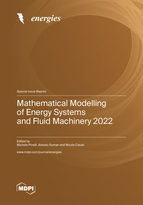Mathematical Modelling of Energy Systems and Fluid Machinery 2022
A special issue of Energies (ISSN 1996-1073). This special issue belongs to the section "J: Thermal Management".
Deadline for manuscript submissions: closed (29 March 2023) | Viewed by 21586
Special Issue Editors
Interests: turbomachinery; energy systems
Special Issues, Collections and Topics in MDPI journals
Interests: turbomachinery; numerical simulation; measurements
Special Issue Information
Dear Colleagues,
It is my pleasure to acknowledge that we are opening for submissions a Special Issue of Energies on “Mathematical Modelling of Energy Systems and Fluid Machinery 2021”. This SI is a continuation of the previous issue “Mathematical Modelling of Energy Systems and Fluid Machinery”. In fact, we experienced huge interest on these topics, and we are sure that this new SI will capture the attention of many other researchers around the world.
Regarding this topic, we underline that (as stated in the previous SI) the digitalization of the energy sector is of paramount importance and, at the same time, an ever-increasing phenomenon. For example, it is worth noting how IoT technologies and the widespread utilization of digital twins are changing the way in which energy systems and fluid machinery are conceived and designed. However, this can only be achieved if these new ICT technologies are posed on solid bases for the representation of energy systems and fluid machinery. Therefore, mathematical modelling is still relevant, and its importance cannot be underestimated.
This Special Issue, which follows the previous one that enjoyed considerable success, is intended for a collection of contributions about the mathematical modelling of energy systems and fluid machinery in order to build and consolidate this base of knowledge.
Authors are invited to submit papers dealing with all aspects of modelling techniques, from the basics of model development (e.g., problem simplification and translation, model implementation, parameter identification, and model validation) to their applications, for all purposes of interest in energy conversion (e.g., linear models for optimization, 3D CFD for component design, dynamic modelling for system control development, CAE models for production, and digital twins for diagnostics and maintenance). In particular, papers based on open source software are very welcome, especially if the source codes are made available to the community through the SI website. Besides original research papers, historical review papers are particularly welcome since they can contribute to the discussion on consolidated assumptions and methodological approaches.
Prof. Dr. Michele Pinelli
Dr. Alessio Suman
Dr. Nicola Casari
Guest Editors
Manuscript Submission Information
Manuscripts should be submitted online at www.mdpi.com by registering and logging in to this website. Once you are registered, click here to go to the submission form. Manuscripts can be submitted until the deadline. All submissions that pass pre-check are peer-reviewed. Accepted papers will be published continuously in the journal (as soon as accepted) and will be listed together on the special issue website. Research articles, review articles as well as short communications are invited. For planned papers, a title and short abstract (about 100 words) can be sent to the Editorial Office for announcement on this website.
Submitted manuscripts should not have been published previously, nor be under consideration for publication elsewhere (except conference proceedings papers). All manuscripts are thoroughly refereed through a single-blind peer-review process. A guide for authors and other relevant information for submission of manuscripts is available on the Instructions for Authors page. Energies is an international peer-reviewed open access semimonthly journal published by MDPI.
Please visit the Instructions for Authors page before submitting a manuscript. The Article Processing Charge (APC) for publication in this open access journal is 2600 CHF (Swiss Francs). Submitted papers should be well formatted and use good English. Authors may use MDPI's English editing service prior to publication or during author revisions.
Keywords
- Mathematical modelling
- Energy systems
- Fluid machinery
- Modelling techniques
- Computational fluid dynamics
- Dynamic modelling








